My Infamous Reverse-Time Tube:
A Thought & Logic Experiment
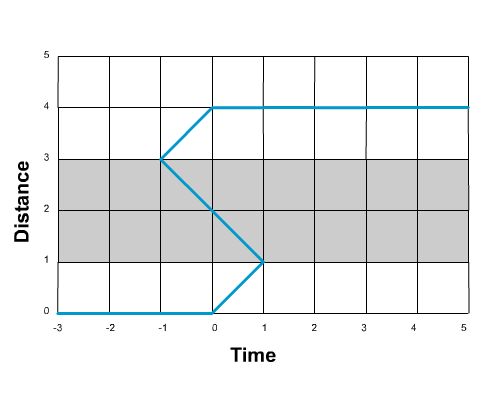
The last article I wrote was about the vagaries of time travel and the whys and hows as to howcome nobody has ever met a time traveler. Keeping with the theme of time variance, I thought it would be fun for me (and hopefully you) to give a good inquiry into an old thought & logic experiment that I first conceived back in college: Chris Harris's infamous Reverse-Time Tube.
Here's the setup to the experiment: Imagine that you had a Tube inside if which time flowed backwards. Now imagine that you sent some object through that Tube, entering in one end and exiting the other end.
What would happen? How would it look to an external viewer (i.e., a vantage point other than the object itself)?
Let's get more specific; let's set some parameters for the actual scene. Your Time Tube is exactly 2 meters long (it doesn't matter how wide it is). 1 meter from the exit of the Time Tube is a target. 1 meter from the entrance of the Time Tube is whatever conveyance you use to launch the object. Let's say the object is a spherical Pellet of some sort. It's launched from some sort of device; it doesn't really matter what type.
Now let's say that the launcher throws the Pellet forward at a speed of 1 meter per second, or 1 M/S. The Pellet's initial location is 1 meter from the entrance of the Tube; the Pellet then travels 2 meters down the length of the Tube, and then travels another meter upon exiting until it strikes the target. 1+2+1 = 4 meters total distance. If it were just a regular Tube in which time flowed normally, at 1 M/S it would take 4 seconds to cross those 4 meters.
Already we've come up against a logic problem, in that this scenario assumes that it is possible to instantly accelerate the Pellet from a relative speed of absolute zero to 1 M/S. Of course this is impossible; there is always some measurable amount of time of acceleration until the Pellet reaches full speed. So let's say that 1 meter from the entrance of the Tube is the exact spot where the Pellet reaches it's full speed of 1 M/S. Let's also say the Pellet is traveling through a perfect vacuum the whole time so we don't have to worry about friction slowing it down, and that its 1 M/S speed is absolutely constant until it hits the target, at which point it decelerates rapidly to zero.
Okay? Okay. We can all imagine now what this would look like if time flowed normally through the Tube. The Pellet would simply travel forward at a constant rate for 4 seconds until it hit the target, at which point it would become motionless.
Click "play" on this animation and you'll see what that looks like. We'll count down to zero, which is the instant that the Pellet reaches full 1 M/S velocity:
That's pretty straightforward, right? Let's graph that out with a graph consisting of time and distance. I'm simplifying it just a little bit by not including the marginal acceleration time, but for our purposes that doesn't matter because the acceleration all happens externally to the Tube itself. In this graph, the turquoise line is the Pellet, and the grayed-out areas represent the interior of the Tube.
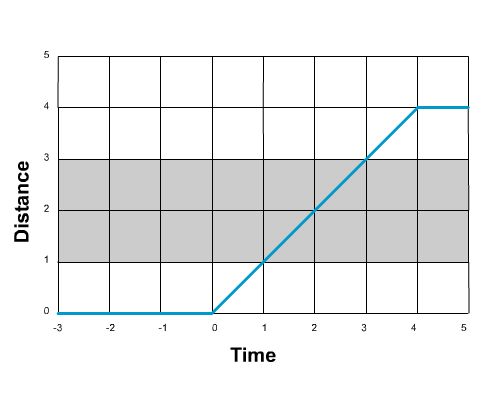
See? The Pellet passes through the Tube at a constant rate and then stops moving once it strikes the target.
Okay, now let's activate the reverse-time property of the Tube. What will happen this time when you launch the Pellet through the Tube to the target?
Well, let's think about this logically. When it enters the Tube, it will start traveling backwards along the time axis, but because of momentum it will still be traveling forward along the distance axis. Time is reversed on at a value of exactly -1, so it is moving backwards through time at the same exact rate that it would normally be moving forwards through time. So if we were to graph that out, it would look like this:

With me so far? You can see the logic in this, right? The Pellet travels forward one meter in both space in time. It then travels backwards in time but forwards in space for two meters. Then once it exits the Tube it begins traveling forward in time AND space once again.
But there are some very weird things happening in this graph. Take your finger and place it on the 0 time line. Where is the Pellet? If you trace up the line, you'll find that the Pellet is actually at 0 distance, +2 distance, AND +4 distance SIMULTANEOUSLY.

What is going on here? And what exactly is going on at -1 Time by +3 Distance or +1 time by +1 Distance?
This is a bit of a brain-bender, I know. It's sometimes difficult to look at a graph and be able to translate that to what it would actually look like to an external viewer while it was happening. That's why I made this following animation. Go ahead and click "play" and you'll see what this graph looks like in action. The traveling vertical line represents the passage of time as experienced by an external viewer.
That hopefully helped you see the actual chronology of events as an external viewer would experience them. But it is still a different experience to look at a graph as opposed to watching the actual event. So, here, click "play" on the following animation and you'll see what this would actually look like from an external vantage point:
WOW! HOLY CRAP! That was friggin' WEIRD.
I recommend you watch that a few more times. Here, I'll break it down for you:
- At -1 seconds, the Pellet appears at the exit of the Time Tube.
- It then travels BOTH to the center of the Tube AND to the target, reaching both those destinations at the 0 mark exactly, at which time the Pellet has been launched from the firing device and has reached it's full 1 M/S velocity.
- The just-launched Pellet then travels forward towards the entrance of the Tube where it meets the Pellet that is traveling backwards through the Tube and they both disappear.
Now go back and re-watch the animation of the graph, then watch the animation of the actual event, and you'll see how they match up perfectly. For a while, the Pellet exists in three different places simultaneously.
In this exact scenario in these exact conditions, the Pellet actually strikes the target AT THE SAME TIME THAT IT IS LAUNCHED AND REACHES ITS FULL VELOCITY. At that exact moment the Pellet is also in the middle of the Tube. And yet, as you can see from the graph, IT IS ALL THE SAME PELLET.
WOW. That's pretty crazy, right? Well, let's not stop there. Let's keep on thinking this thing through logically.
These graphs and animations have been very simplified. The Pellet as it is represented on the graphs is essentially a one-dimensional object. But of course an actual Pellet will have its own width, small though it might be. What does that mean for our experiment, though? It means, quite simply, that the Pellet will not be entering the Time Tube all at once; the front edge of the Pellet will enter the Time Tube some measurable fraction of a second before the trailing edge of the Pellet enters the Time Tube.
But what does THAT mean?
Well, let's think about it a bit differently. Let's treat the front edge of the Pellet and the trailing edge of the Pellet as two different objects entirely. Let's say the front edge is a green one-dimensional object, and the trailing edge is a purple one-dimensional object. Well, what would happen if you launched two different objects through the Time Tube, one after the other? Let's graph that out very simply:
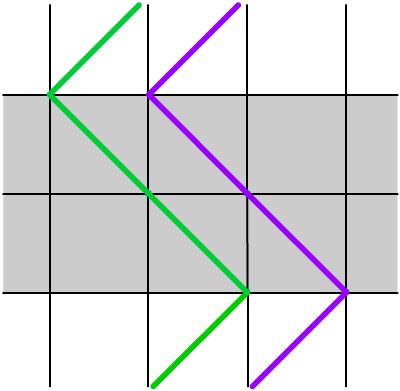
So, as you can see, the green Pellet enters the Tube first, then the purple Pellet. The green Pellet will also strike the target before the purple Pellet. Looks all good and normal, right? Well, look at what's going on inside the Tube. While both Pellets are in the Tube, their positions in space are actually REVERSED. Here, I'll circle what I'm talking about:
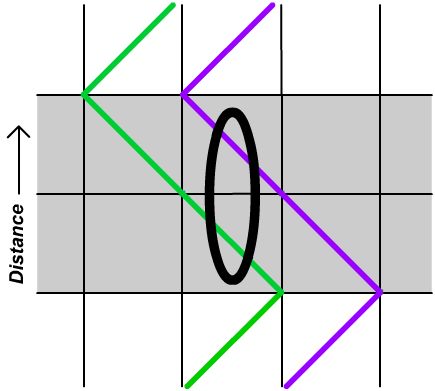
See that? While they're on the outside of the Tube, the green Pellet is further in distance than the purple Pellet. But inside of the Tube, the purple Pellet is actually further in distance than the green Pellet.
Now let's imagine that instead two separate green and purple Pellets, we just have one Pellet, the leading (right) half of which is green and the trailing (left) half of which is purple. Press play and let's see what that would look like:
THERE! Did you see that? The Pellet inside the Tube was green on the LEFT side and purple on the RIGHT side! It was an EXACT MIRROR IMAGE of the Pellet when it was on the outside of the Tube!
That might not make any sense to you, but just think about it for a bit. Look back at the green/purple graphs, then watch the animation a couple more times. You'll see. Because the green part enters the Tube first, it is farther back in time, and therefore farther left in distance, than the purple part, which is farther forward in time and therefore farther right in distance.
I know that might be a lot to wrap your head around, but we aren't done yet; not by a long shot. These animations so far have been very simplistic. Due to size and frame rate (they're only 12 frames per second (fps) after all) we're not really getting a clear view of what happens at the entrance and exit of the Tube. In the animations it just seems that the Pellets *boink* APPEAR at the exit of the Tube, and then two seconds later they just *boink* disappear at the entrance of the Tube. But that's not quite the whole story. The Pellets actually do take some fraction of a second to cross the threshold on both ends of the Tube.
So let's just zoom in on those parts and slow the footage way, way down. What does it actually look like at the exit of the Tube? Well, here's a closeup at a much, much slower speed (the dotted line represents the exiting edge of the reverse-time effect). Press play and let's see what happens:
See, the Pellet doesn't just spring spontaneously into existence. It is actually extruded by the edge of the field in both directions. In this way you can also see why it makes sense that the interior-field Pellet would be an inverse version of the exterior-field Pellet; would it make sense to have purple touching green in this scenario? That would be like going back to the purple/green graphs and arbitrarily switching the colors of the lines while they're passing through the gray area of the graph. That wouldn't make any sense to do.
Now let's zoom into and slow down the entrance of the Tube. I think you'll probably guess what's going to happen here where you press "play" so let's see if you're right:
See, the Pellets outside and inside the Tube kind of "merge" into one another at the threshold of the Tube. It may seem weird, but just think about it for a bit. Imagine that every single, infinitesimal, vertical slice of that Pellet were its own object, then graph each one of them. You'll see that the results are inevitable.
We've been assuming up to this point that it is actually possible for an object to pass the threshold of the Time Tube and still remain intact. I'm not entirely sure that that is the case, seeing as how passing the threshold basically turns an object inside-out. I'm also not entirely sure that activating a reverse-Time Tube wouldn't result in a catastrophic explosion the likes of which the universe has never seen before since the Big Bang.
In other words, there's one more though experiment I want to conduct with this Time Tube before we're done.
In all the scenarios we've seen where the Pellet goes backwards in time through the Time Tube, the Time Tube has been "activated" for an arbitrarily long amount of time before the Pellet has been fired. Hence why the grids of the various graphs are grayed-out all the way from the left edge to the right edge of the graphs. But what would happen if you activated the reverse-time effect at the same instant that you launched the Pellet?
Well, let's think about it. The Pellet would travel +1 Distance and +1 Time. It would then enter the Tube and travel +1 Distance and -1 Time, at which point it would have traveled back in time to the point when the reverse-time effect was activated. It can't go back in time any further, because if it does it will have entered a forward-time zone. But it also can't start going forward in time again, because if it does it will have entered a reverse-time zone. An object cannot move opposite of the flow of time, but if you think about it, forward-flowing and reverse-flowing time actually meet head-on the instant the Time Tube is activated:
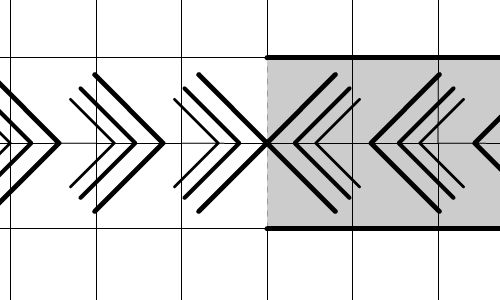
So what does that mean, exactly?
Well, imagine you're driving a car due east and you want to turn it around so that it's going due west, thereby reversing the car's direction. This is essentially what you're doing with time when you turn on the Time Tube. So you're driving due east and you make a big, sweeping left turn until you're driving due west. Now, assuming that you're making either a perfect circle turn or (more likely) a parabolic turn, there is going to be one point in your turn where you are facing neither east nor west, but exactly due north. You will be exactly perpendicular to both east and west.
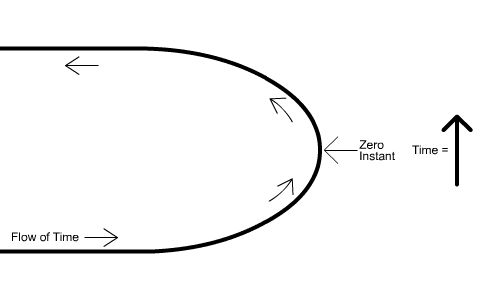
It is the same with reversing time. There is going to be a point -- one singly, solitary, infinitesimally small point -- where time is flowing neither forward nor backwards, but perpendicular to both. I call this instant where time is moving perpendicular the "Zero Instant."
But remember, the Pellet you fired into the Tube is still moving forward in space. What would that look like?
Well, let's graph it out. Remember, in white spaces the Pellet must travel forward in time, and in grayed-out spaces the Pellet must travel backwards in time. But on the razor's edge between those two zones, it can travel NEITHER direction in time, but still forward in distance. Graph that out and it would look just like this:
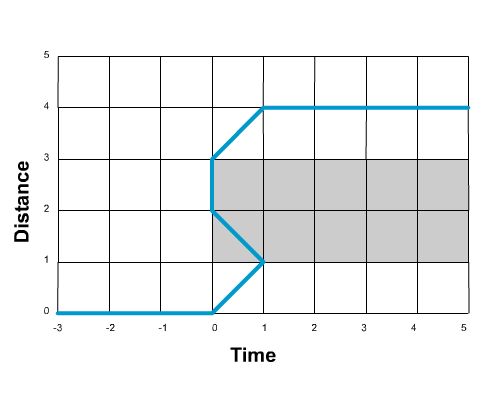
Now if you just look at the 0 time axis, you can see that the Pellet exists along the 0 time axis at ALL points between +2 and +3 Distance SIMULTANEOUSLY. Is this even possible? Seriously, I'm asking this for real; this part of the thought experiment is beyond my conceptual knowledge. It's not like the Pellet would be distinctly separated from itself along that 0 time axis; it would occupy simultaneously every single 1.616252(81)×10-35 metres of space that it traveled through. There would be a lot of overlap. Can two+ objects occupy the same space at the same time?
Again, what does that mean?
Let's think about this in a different way. Let's imagine that you place a Pellet perfectly stationary in the center of the Tube and then count backwards from 3, activating the reverse-time effect exactly at zero. What would happen to that Pellet? Well, the first part of that is easy: it would be traveling forward in time but not traveling either forward or backwards in distance. But then as soon as you activate the reverse-time effect, the Pellet would enter the Zero Instant. It travels neither forward nor backward in time.
Now let's think about that from our external vantage point. The Pellet exists in the seconds leading up to zero, but it cannot exist in the seconds that come after zero; otherwise it will be moving forward in time. Therefore does the Pellet simply cease to exist?
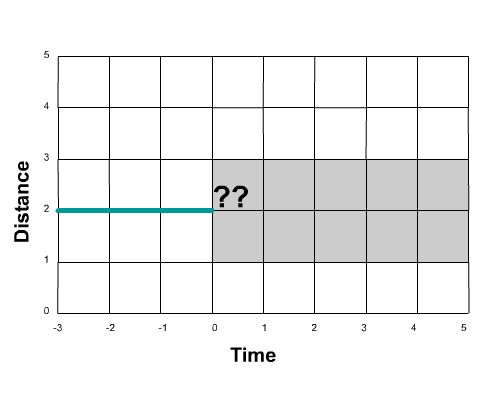
Well... not exactly.
Let's imagine now that YOU are the Pellet. You're placed absolutely motionless inside the Tube. The Tube is activated. Now what happens to you? From your point of view, you don't cease to exist. But you're now traveling through time perpendicular to the regular flow of time. To you, all time outside the Tube grinds to a complete halt. The whole universe outside is in temporal stasis from your point of view. Even more strangely, though, you now occupy the same temporal space as your own past. Every single moment of time since you entered the Zero Instant exists simultaneously with the present moment.
How long would you be stuck in the Zero Instant? You might think that the Zero Instant would last only as long as the reverse-time effect is activated, right? As soon as someone turns off the reverse-time effect, you'll be freed from the Zero Instant, right? WRONG. Remember that time has come to a complete stop outside of the Time Tube. Therefore from your point of view nobody will ever turn off the reverse-time effect. EVER. From your point of view the Zero Instant by its very nature can NEVER end.
To an external viewer, the Zero Instant lasts an infinitesimally short amount of time. But from a subjective point of view from inside the Zero Instant, the Zero Instant lasts literally FOREVER. An actual eternity of time is compressed into the Zero Instant.
But the Pellet would not exactly be trapped in the Zero Instant forever. Seeing as how the Pellet would exist in the exact same temporal space as ALL of its past selves, I'd imagine that there would be less and less chance of something catastrophic NOT happening. The idea of atomic nuclei existing in the exact same space and time as other atomic nuclei strikes me as being horrendously unstable.
Even if an atom can somehow survive existing in the same place at the same time with its past self, eventually (from the Pellet's point of view) the Pellet's atomic structure would start breaking down. Since all systems tend towards chaos and entropy can not be defeated, electrons would start losing their bonds and flying away from the Pellet's atoms, eventually escaping from the edges of the Tube itself. And then the atoms of the Pellet itself would begin to degrade, perhaps after billions of subjective years even going so far as to break down 100% into various gamma rays, beta rays, pure energy, etc., which would also escape from the open ends of the Tube.
The thing is, all of this energy, because it is in the Zero Instant, would escape from the edges of the Tube AT the Zero Instant. From an external viewpoint if you placed something motionless inside the Tube and then activated the reverse-time effect, at Zero Instant the entire object would be converted into its equivalent of energy (E = MC2 after all) and come flying out of both ends of the Tube simultaneously.
I.E., it would cause a massive, unbelievably concentrated burst of energy to come flying out of the Tube. Depending on the mass of the object, it could be an explosion the likes of which the universe probably doesn't see that often.
That's one way of looking at it. As I said, my knowledge of hypothetical quantum physics breaks down about now, so I have no idea what would actually happen. Here's another way of looking at it. You know what a gravitational singularity is? That basically when spacetime gets curved to such an extent that it reaches a single, infinitely-small point that does not have any spatial dimensions. That's of course simplifying things quite a bit, because there are rotating singularities and ring-shaped singularities and all sorts of crazy stuff.
Well, essentially what we're creating with the Zero Instant is a temporal singularity. We're taking the time axis of 4-dimensional spacetime and curving it (without disturbing the space axes) so much that it loses its dimensionality. It becomes infinitely dense. What the heck would that do to regular spacetime?
Again, I have no idea, and so my thought experiment must end here, having reached the limits of my non-mathematical logic abilities.
But I sincerely hope you enjoyed (and understood) this metaphorical trip down the rabbit hole of graphs and logic and messed-up time.
Related Articles: |
